Offering a great new information source for haunters
This blog is based on the very first episode of the A Scott in the Dark podcast. I was so excited to begin this new adventure, which is designed for and targeted to haunters. My name is Scott Swenson, and I want to start off by telling you a little about myself.
How I Became a Haunter
All of us have stories about when we started becoming fascinated by the haunted attraction industry. For me, it was when I was seven or eight years old. One of my best friends said to me, “My sister is doing a haunt in our basement. Why don’t you come over and be one of the monsters?” So, I did. I don’t remember a whole lot about that particular haunt except for the fact it was the day I learned it’s a bad idea to use red nail polish as blood on your face. It doesn’t work at all—or, I should say, it works quite well, because it never comes off. You have to pick at it forever and, since it was right by my eye, using nail polish remover wasn’t a good experience.
After that very early attempt at doing haunts, I took a break for a while. It wasn’t until about 1999 that my career took me back into the haunt industry. In 1999, I was part of a brand-new haunted attraction at Busch Gardens in Tampa called Spooky Safari. I played one of the icon characters—Doctor Simon Livingsdoom—who was a really creepy dude. It was a lot of fun, and, the following year, the park wanted to make it bigger and better, and I was lucky enough to be selected to be part of the team to create that haunted attraction—which is still running as Howl-O-Scream.
I remained with that project for its first 15 years as part of the creative team as well as the operational team. I was the creative director for about nine of those years and the creative producer for about two. I had the opportunity to work with some really wonderful and cool people, and that’s what kinda got me hooked into the haunt industry.
Since leaving Busch Gardens in 2014, I’ve gone on to create my own company called Scott Swenson Creative Development LLC. I’m basically an entertainment consultant, and I work for events ranging from zoos and aquariums to independent haunts and theme-park haunts. I’ve written haunted attractions for various and sundry places including Valley Fair in Minneapolis. I’m the creative writer and director for the Vault of Souls here in Tampa, and 2017 marked its third year. There are some major changes coming, and hopefully, I’ll get a chance to talk about that in a future podcast
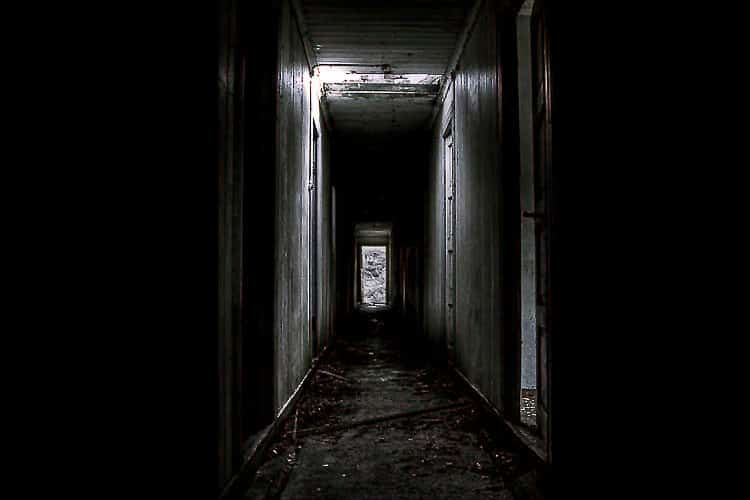
The Birth of A Scott in the Dark Podcast
The idea behind doing this podcast came about when I was teaching a seminar at the Midwest Haunters Convention. I teach a lot of seminars, and I’m lucky enough to have people continue to want to hear them. After one of my seminars, someone said, “You know, Scott, it would be really fun if you were able to share this information online somehow through vlogging or podcasting.” I thought that would be really cool, but it took me more than a year to figure out the technical side of making it happen. I’m still learning, so there will likely be some technical glitches in the podcasts for a while.
What I want to do in these podcasts and blogs is share information on specific topics in each episode. Each episode will have its own focus and, in each one, I want to share with haunters some of my experience as well as some of the things I’ve thought of and never tried. I think this will appeal to people who run haunted attractions, people who work in haunted attractions, and people who’d like to do either of those things but haven’t quite figured it out yet.
There will also be something in future podcasts and subsequent blogs for the fanboys and fangirls out there who are even more into the haunt industry than we in the haunt industry are. I’m talking about the people who can tell me what the third haunted house was that I wrote in 2014 for Busch Gardens Tampa. I don’t remember, but some of the great fan people do. So, hopefully, they’ll find something to like in these podcasts and blogs as well.
The Basics of Scare
Since this is the very first podcast, I thought it might be fun just to talk about the basics of scare. You can talk to a whole bunch of different haunters, and each one of them will give you a different view on this. My whole perception is you’re telling a story. I’ve always called myself a storyteller, whether I’m producing shows, writing shows, or even acting in them. It’s all about telling a story that has a beginning, a middle, and an end, and involves the guests that walk through it. It’s essentially immersive theater.
I’ve done several articles and several classes about how to incorporate the story into your haunted attraction, and we’ll focus on that in another episode. A haunt has to start with a story, and you have to make certain that the story is compelling, has characters that people will enjoy, and affects them on an emotional level.
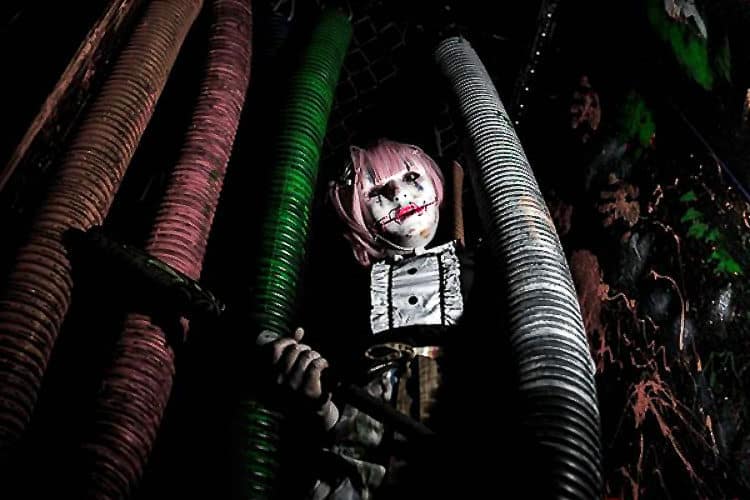
“If It Scares People, It’s Right”
In my career, I’ve done haunts that range from super bloody and gory to no blood, guts, or gore at all. People ask me, “Which do you like better? Which is right or wrong?” The answer is, if it scares people or creeps them out, it’s right. If it doesn’t, it’s wrong. The content depends on your audience, and you have to make sure you communicate that clearly in advance, so everybody has an understanding of what they’re in for. You want to surprise people, but you don’t want to piss them off by stating the haunt has no blood, guts, or gore, and the first scene is the decapitation of a child. I’ve never done that in a haunt, but I’ll tell you a funny story. There were times we, at Howl-O-Scream, went a little too far. There was a haunted attraction I did for Howl-O-Scream several years ago called Trapped in the Walls. Basically, Trapped in the Walls was all about this house that became possessed, and all the people in that house ended up killing themselves or each other. As guests went through the haunt, they were almost like investigative reporters walking between the walls—hence the name Trapped in the Walls—looking into scene after scene after scene of bloody carnage. At the time, I thought, “We might get some letters on this one.”
What was interesting is that nobody sent a single letter or had a single complaint about all the human carnage that was going on. However, in the kitchen scene, the family dog had been fileted open on the kitchen table. Now, before you start yelling at me and sending me nasty emails about pet abuse, it was a FAKE dog. I’m a huge supporter of dog rights, so don’t even go there. It’s supposed to be horrifying. That was the thing that got letters. We didn’t get letters about the person who’d put their head into an electric oven and there was the sound of fat dripping and hitting the coils as though their face was melting in the oven. That didn’t get a letter. The human being next to the dog that was sort of slumped over the table with 15 forks stuck into their back didn’t get a letter. The other character who’d cut off and was eating his own hand—no letter on that, either. But the bisected dog got lots of letters.
So, you never know quite how guests are going to respond, and although blood, guts, and gore are great, you don’t always need that. As long as it fits with the story, and as long as you can communicate it to guests before they enter your haunt, you’re in great shape.

The Two Types of Scares—Atmospheric and Startle
The way I look at it, there are two basic categories of scares—atmospheric and startle. I believe you need to have a balance between the two. Now, obviously, a more aggressive haunt will have more startles, especially if it’s one of the conga-line, theme-park haunts where you can’t batch groups. Everybody is sort of back to chest and going through in one steady line. You want to have a lot of startle scares in those. However, if there are just startles, that gets old very fast. With an atmospheric scare, you use those startles to build anticipation. You set the mood, so to speak, of the room or the haunt. These can be also be very entertaining.
Often, the queue line is where most atmospheric scares happen—somebody wandering around the queue being entertaining, having a great time, and establishing a little bit of the backstory. That’s a great use of atmospheric scares, and it also puts people in the right mindset. They’ve learned something about where they’re going. So, use those atmospheric scares to tell that backstory. Atmospheric scares also serve as a great distraction from a startle scare. If you’ve got a room with a little girl crying and cradling her doll in the corner, everyone will be looking at that particular character. While they’re doing that, some giant, ax-wielding maniac can provide a scare from the other side of the room.
You Want to Make People Scream
Startle scares are the ones that make people scream—which is what most haunters want to hear in their haunted house. If you’re standing outside and you hear people screaming, you know you’re doing something right. Haunt actors love startle scares. They love to make people scream, cry, and—yes—wet themselves from time to time. That was a big badge of honor in some of the haunted houses I’ve worked in. One time, an actor came backstage dancing and smiling, and we were like, “What’s up?” He started dancing and singing, “I made a big guy pee, I made big guy pee.” We’ve all seen those haunt actors who get such a charge out of scaring the heck out of somebody. That’s what a startle scare does.

Using Startle Scares to Direct and Distract
There are also practical reasons for a startle scare. Startle scares can move guests in a desired direction. You can use a startle scare to push guests forward, but, the one thing you have to remember with a startle scare is there’s going to be an angle of attack and an angle of retreat. When you startle-scare someone, they’re going to do one of two things, because the natural response is either fight or flight. They’ll either not move and go toe to toe with you as a haunt actor, or they’ll run away. The thing you have to make certain of with a startle scare is that you’re not scaring the guest into a trip hazard or into a prop you don’t want broken. So, make sure the angle of attack is in the direct opposite the direction of the angle of retreat.
I always advise scaring from the side or from behind. If you scare from the front, you’re going to reduce the guest’s ability to flee and increase the likelihood they’ll fight you, and none of us want that. There’s enough of that going on in haunted attractions without us encouraging it. That’s one of the most important things to remember about startle scares from a safety standpoint.
You can also use a startle scare to distract from a follow-up startle scare. I always like to put actors on opposite sides of the room, so they scare from one side to the other. Unfortunately, all too often, when novice actors get into a haunt situation, they all want to scare at the same time. If there are three haunt actors in the room, and they all do their startle scare at the same time, it’s one big startle scare, but it could be three, really cool startle scares. You reduce the number of scares when that happens. It’s like guests are scared all at once, and then they walk through the rest of the room and nothing happens. I always encourage my actors to scare after the actor ahead of them. They also need to know what the previous startle scare is so they can hit guests appropriately afterward.
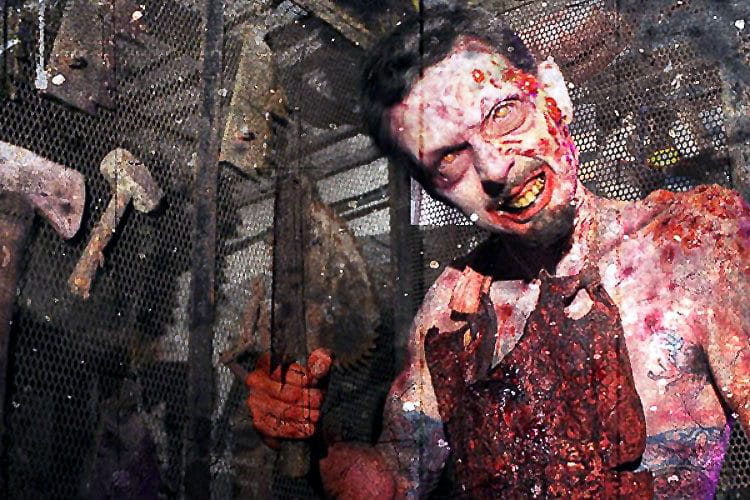
The Importance of Misdirection and Timing
The other thing that makes scares work—or not—is misdirection and timing. Misdirection is a term used in magic, and it means focusing the guests’ attention somewhere else so you can make something happen. In magic, they’re usually making you look at the right hand while the left hand is doing something sneaky, or they’re having you look at the beautiful young assistant so you don’t notice the remarkably thick stairs they used to get her into that box are being wheeled away. Could those stairs possibly hold a person? Hmm.
Misdirection can also help distract from what guests expect. Now, as I said earlier, guests need to understand what they’re getting into, but there always have to be surprises. You can use misdirection and say, “Everything is going to be okay,” and then hit them with something big and scary. That works amazingly well.
I always call timing the heartbeat of a haunted attraction. When haunted attractions are really working, there’s a rhythm all the performers can feel. They know when it’s working, they know when that scare and that reset are happening at the right times, they know when a guest is being scared from one performer to the next performer to the next performer, and they know when a giant animation, air cannon, lighting effect, strobe effect, or something like that is happening. It really is the heartbeat. As a scare director—if you own your own haunt and manage your people—or a scare actor, you have to encourage waiting for the right moment. Often, it’s the sense of anticipation before the startle scare that makes it work. This goes back to the idea that you don’t want all the actors in the room to scare at the same time. Scaring is a team sport, and that’s where the heartbeat—the timing—and the misdirection come in.
Timing can also help control your guest flow. If you have a crowded room, you can either startle scare guests forward or realize it’s best not to do anything and let them walk through the room to clear that space a little bit. Then, just as they get to the door, hit them with a startle scare.
One time, when I was walking around a large, outdoor haunted attraction—dressed not as a monster but as a supervisor in a black staff shirt—I discovered my timing was better than I thought. I was scaring people just by walking. Some of you may have met me—and hopefully, I’ll get a chance to meet a lot more of you, because I’ll be at a lot of haunt conventions coming up in the future—but, for those who haven’t, let me say I’m a big guy. I’m 6’4”, I weigh a lot, and it seems I’m a lot more stealthy than people expect me to be. Apparently, I can walk quietly. So, I’d walk up behind a guest to make sure everything is working right at the haunt, and the guest would turn and start screaming hysterically because they had no idea I was there.
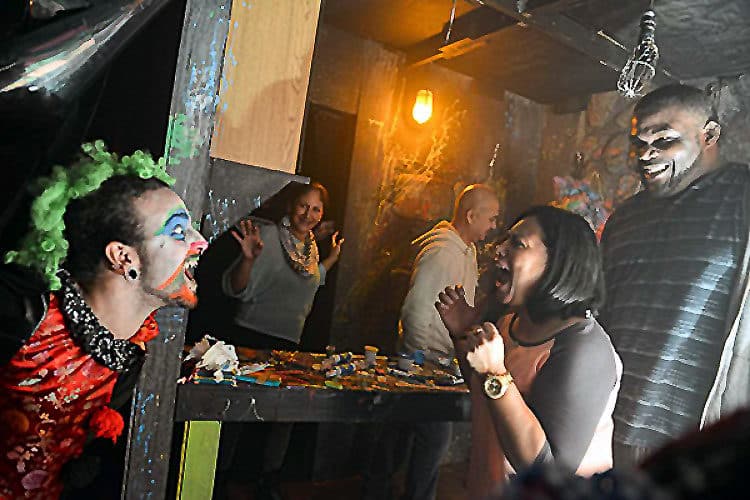
Hide in Plain Sight
The other thing you have to pay attention to when it comes to timing is the ability to hide in plain sight. If you’ve got great timing, you don’t need something to hide behind, you don’t need a drop door. You can use guests to hide behind. When I was at Busch Gardens in Tampa, we had sliders. I’m sure some of you know about sliders, but, for those of you who don’t, sliders are very athletic performers who wear shin guards, steel-toed boots, run out of the darkness, and, as they run, they lower themselves to their knees, slide across the ground, and then jump up and scare the heck out of people. They also throw off sparks, especially if they have flint embedded in their shin guards, toe guards, or gloves. They do some amazing things.
These guys don’t hide behind anything. They either stand there, completely still, or they’ll use the crowd to hide behind. In other words, you have guests heading northbound on a path and guests heading southbound, and the sliders will hide behind the northbound guests to scare the southbound guests. It’s remarkable how it works, and it really has to do with timing and being focused.
The Importance of the Storyline, or “Where the Hell Did that Clown Come From?”
Now, I started this whole conversation talking about story. I’m in the midst of writing a four-part article for the Haunt Journal Magazine (now called Seasonal Entertainment Source) called Follow the Story. The storyline is so vitally important. All too often, beginner haunters decide they’ll go to a trade show and buy everything they think is cool. Unfortunately, if you just buy the things you think are cool, and you don’t have a storyline to link them together, it’s just confusing and not that scary.
If I’m teaching live, I usually call this portion of the seminar, “Where the hell did that clown come from?” We all want to put clowns in our haunt but, if your haunt is all about vampires in a subway and all of the sudden a clown shows up, it makes absolutely no sense. Yes, people are afraid of clowns and, if you can find a way to work a clown into your story, that’s fine. However, your story needs to be your backbone so you can add the flesh of your haunted attraction onto it. It needs to provide your support, create a sense of history, and create a backstory so the guests’ journey doesn’t start with, “Where are we?” They need a little exposition. Just as you use atmospheric scares to tell your story when it’s happening, use your website and social media to help tell that story before guests even get there.
The story for Vault of Souls, for example, which is the haunted attraction for which I was hired to be the creative director and writer in 2015, is all based on the history of downtown Tampa. This haunt is set in the 1920s, because that’s when the building the event takes place in was constructed. It uses all kinds of local history and transports people back to the 1920s. The history helped me make a lot of decisions, because I always asked myself, “Is this something that would have made sense in 1923? No? Well, maybe I should try something else.”
The story helps you define your characters. It helps you chase away the clowns, unless that’s appropriate. It also helps you set up the guests so that, with each step along the way, they’re getting closer and closer to the climax, closer and closer to something big and horrendous. It also helps focus your design. If you’ve got a 1920s theme, there not only won’t be cellphones in there but there wouldn’t be a television. The design needs to make sense ,so guests stay immersed throughout the story.
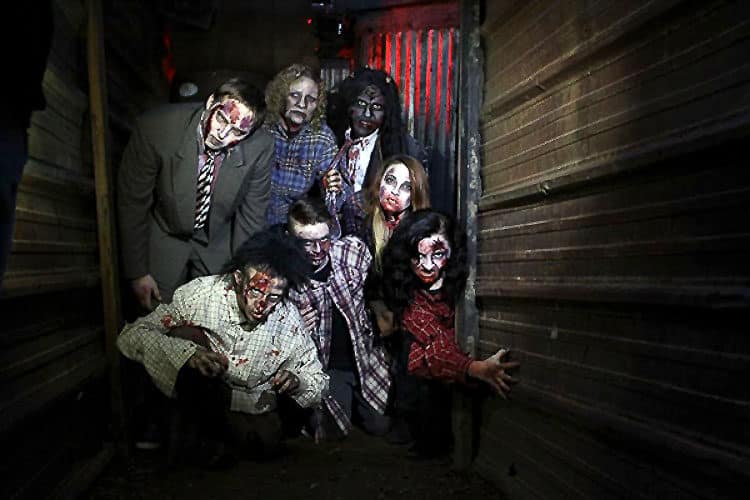
How Having a Story Helps You Budget
The story can help you identify budgetary issues. If you’re on a limited budget, do not—and, trust me, this is the voice of experience speaking—set your haunt attraction in the 1920s. It will blow your budget right off the bat. It’s really hard to find or replicate the venues, props, and costumes that fit in that theme. If you’re on a budget, one of the things I suggest is to try a junkyard theme. This is why so many people do cannibalistic hillbillies. All you need is broken furniture and some Great Stuff to do a really effective haunt—if you’ve got a great idea and some cool actors.
Even in a theme park, there are times when budget becomes an issue. In one of the years of Howl-O-Scream at Busch Gardens, we had an extra location, but we didn’t have a house budgeted to go in there. We had some money to spend, but not nearly as much as we normally had. So, we went to the warehouse, looked at all the parts and pieces we hadn’t used in several years, and decided we’d set this particular haunted house in a junkyard where things were being separated to be recycled. That way, it didn’t look the same in every single area. There was an area that was chain-link fence, an area that was a bunch of old doors, and an area that was a bunch of columns or tubes or PVC pieces.
When in doubt, it seems a lot of us go to zombies. So, what we did in this junkyard haunt setting was create a zombie backstory. This is how what we called the ZCU, zombie containment unit, was created. We set up this maze of junk we’d found in the warehouse and created this backstory about an apocalypse in the future in which zombies weren’t killed. There was a law passed that referred to them as “Undead Americans,” and, instead of being killed, they were fitted with a restraining collar and placed into these zombie containment units. In our story, one of those containment units—the one that just happened to be next to the recycling plant—had broken down and the zombies had escaped. Our guests were given these laser rifles that would temporarily disable the zombies. The goal was to go into this space with these laser rifles—yes, it was laser tag—and shoot the zombies so they could be returned to the containment unit and make life safe for everybody. It turned out to be an amazingly successful concept. It worked really well, and guests had a lot of fun. In fact, I think they’re still doing this at Howl-O-Scream.
If you’ve got a good story, you can make the things you have or can actually afford to buy work really well. You don’t need apologize if you don’t have money for five-story sets, flamethrowers, or things like that, but you may have enough money to do a broken-down shack. You can make something pretty scary if that broken-down shack has a backyard with a barbeque pit. Hey, I’m starting to see those hillbillies eating human flesh. If you do it well, it works, and you can use your story to refine ways to use what you have. So, I always, always, always encourage people to develop a really strong storyline.
So, in this first blog of A Scott in the Dark, we’ve covered some of the basics. I have a whole bunch of ideas for future podcasts, but I also really want to hear from you about what you want to hear about, topics that would be helpful for you, and whether you want me to talk about actor training or the basic concepts of putting together a haunt. We can talk about costumes, scenic design, lighting design, audio design, the use of aromas, marketing, or whatever you guys want me to talk about.
If you’d like to ask questions, suggest topics, or even make comments on what I’ve said or written on any podcast or blog, please go to our Facebook group, go to AScottInTheDark.com or my website, or email me at [email protected]. Until next time, rest in peace.
